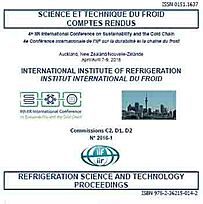
IIR document
Relating microbial growth to volatiles production in cooked ham in view of the development of a fast method of quality assessment in the cold chain.
Author(s) : NDOYE F. T., STAHL V., HEZARD B., et al.
Summary
Bacterial metabolism in sensitive food products such as cooked ham leads to off-odour and/or off-flavour due to volatiles production. It is obvious that the actual time-temperature profiles a food product undergoes are of paramount importance for ensuring food safety and quality. In this study, spoilage experiments were conducted on modified atmosphere packaged sliced cooked ham stored at different temperatures (2, 8, 12, 15°C) during 7 weeks. For each storage temperature, the evolution of volatiles was monitored over time (at 0, 7 14, 29, and 48 days of storage) using static headspace gas chromatography. The production of ethanol, as a representative volatile deriving from bacterial metabolism, was correlated to lactic acid bacteria, especially Leuconostoc, outgrowth. A threshold value of ethanol concentration was defined in relation with a threshold count numbers of lactic acid bacteria under the conditions studied. Thus, volatiles analysis is proposed as a fast method to assess the bacterial spoilage status of cooked ham during storage and distribution through the cold chain.
Available documents
Format PDF
Pages: 8
Available
Public price
20 €
Member price*
Free
* Best rate depending on membership category (see the detailed benefits of individual and corporate memberships).
Details
- Original title: Relating microbial growth to volatiles production in cooked ham in view of the development of a fast method of quality assessment in the cold chain.
- Record ID : 30017488
- Languages: English
- Source: 4th IIR International Conference on Sustainability and the Cold Chain. Proceedings: Auckland, New Zealand, April 7-9, 2016.
- Publication date: 2016/04/07
- DOI: http://dx.doi.org/10.18462/iir.iccc.2016.0059
Links
See other articles from the proceedings (63)
See the conference proceedings
Indexing
-
Use of natural volatile compounds for preservin...
- Author(s) : ARCHBOLD D. D., HAMILTON-KEMP T. R., LANGLOIS B. E., BARTH M. M.
- Date : 1996/10/02
- Languages : English
- Source: New Developments in Refrigeration for Food Safety and Quality.
- Formats : PDF
View record
-
Improvement of food safety and shelf life of re...
- Author(s) : BARON-YUSTY M., ROS-CHUMILLAS M., LÓPEZ GÓMEZ A., MARTÍNEZ HERNÁNDEZ G. B.
- Date : 2022/04
- Languages : English
- Source: XI Congreso Ibérico y IX Congreso Iberoamericano de Ciencias y Técnicas del Frío, CYTEF 2022.
- Formats : PDF
View record
-
Modified atmosphere packaging to extend shelf l...
- Author(s) : TABOADA-RODRÍGUEZ A., SÁNCHEZ-RUBIO M., CAVA-RODA R., et al.
- Date : 2015/08/16
- Languages : English
- Source: Proceedings of the 24th IIR International Congress of Refrigeration: Yokohama, Japan, August 16-22, 2015.
- Formats : PDF
View record
-
Storage of carcasses, cuts and consumer portion...
- Author(s) : SHAY B. J., EGAN A. F., BILL B. A.
- Date : 1992/08/23
- Languages : English
- Source: 38th International Congress of Meat Science and Technology (ICoMST). Proceedings.
View record
-
How the cold chain impacts the shelf life of a ...
- Author(s) : BEAUFORT A., GUILLIER L., DURET S., et al.
- Date : 2013/04/02
- Languages : English
- Source: 2nd IIR International Conference on Sustainability and the Cold Chain. Proceedings: Paris, France, April 2-4, 2013.
- Formats : PDF
View record
